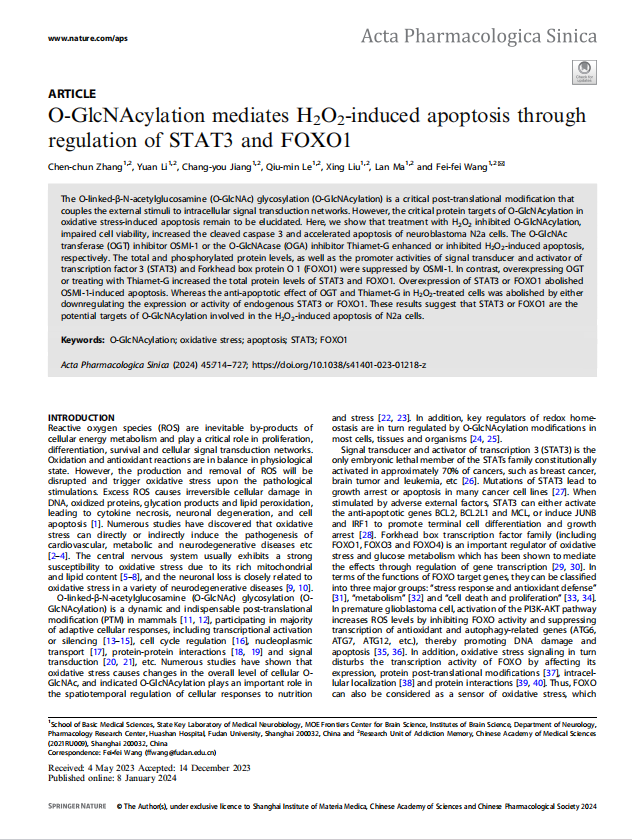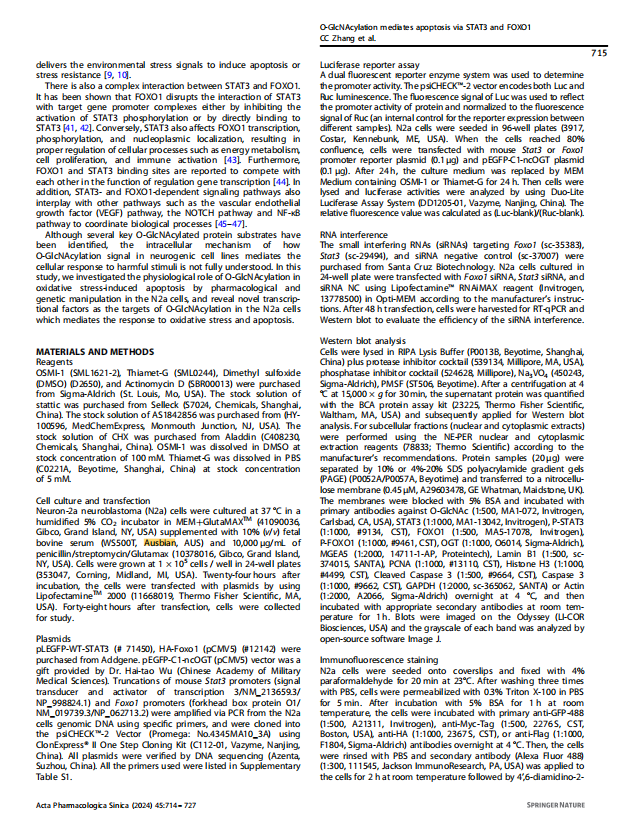O-GlcN酰化通過調控STAT3和fox01介導H2O2誘導的細胞凋亡 二維碼
發表時間:2024-08-20 16:07 2024年1月,復旦大學附屬華山醫院藥理學研究中心神經內科腦科學研究所教育部腦科學前沿中心醫學神經生物學國家重點實驗室基礎醫學院;中國醫學科學院成癮記憶研究室,(1 School of Basic Medical Sciences, State Key Laboratory of Medical Neurobiology, MOE Frontiers Center for Brain Science, Institutes of Brain Science, Department of Neurology, Pharmacology Research Center, Huashan Hospital, Fudan University, Shanghai 200032, China and 2 Research Unit of Addiction Memory, Chinese Academy of Medical Sciences(2021RU009), Shanghai 200032, China )Lan Ma1,2 and Fei-fei Wang1,2團隊在 《acta pharmacologica sinica》上發表論文: “O-GlcNAcylation mediates H2O2-induced apoptosis through regulation of STAT3 and FOXO1” “O-GlcN酰化通過調控STAT3和fox01介導H2O2誘導的細胞凋亡” Abstract: The O-linked-β-N-acetylglucosamine (O-GlcNAc) glycosylation (O-GlcNAcylation) is a critical post-translational modification that couples the external stimuli to intracellular signal transduction networks. However, the critical protein targets of O-GlcNAcylation in oxidative stress-induced apoptosis remain to be elucidated. Here, we show that treatment with H2O2 inhibited O-GlcNAcylation, impaired cell viability, increased the cleaved caspase 3 and accelerated apoptosis of neuroblastoma N2a cells. The O-GlcNAc transferase (OGT) inhibitor OSMI-1 or the O-GlcNAcase (OGA) inhibitor Thiamet-G enhanced or inhibited H2O2-induced apoptosis, respectively. The total and phosphorylated protein levels, as well as the promoter activities of signal transducer and activator of transcription factor 3 (STAT3) and Forkhead box protein O 1 (FOXO1) were suppressed by OSMI-1. In contrast, overexpressing OGT or treating with Thiamet-G increased the total protein levels of STAT3 and FOXO1. Overexpression of STAT3 or FOXO1 abolished OSMI-1-induced apoptosis. Whereas the anti-apoptotic effect of OGT and Thiamet-G in H2O2-treated cells was abolished by either downregulating the expression or activity of endogenous STAT3 or FOXO1. These results suggest that STAT3 or FOXO1 are the potential targets of O-GlcNAcylation involved in the H2O2-induced apoptosis of N2a cells. 摘要: O-linked-β- n -乙酰氨基葡萄糖(O-GlcNAc)糖基化(o - glcnac酰化)是一種關鍵的翻譯后修飾,將外部刺激與細胞內信號轉導網絡偶聯。然而,o - glcn酰化在氧化應激誘導的細胞凋亡中的關鍵蛋白靶點仍有待闡明。在這里,我們發現H2O2處理抑制o - glcn酰化,損害細胞活力,增加裂解caspase 3,加速神經母細胞瘤N2a細胞的凋亡。O-GlcNAc轉移酶(OGT)抑制劑OSMI-1或O-GlcNAcase (OGA)抑制劑Thiamet-G分別增強或抑制h2o2誘導的細胞凋亡。OSMI-1抑制了總蛋白和磷酸化蛋白水平以及轉錄因子3 (STAT3)和叉頭盒蛋白O1 (FOXO1)的啟動子活性。相反,過表達OGT或用Thiamet-G處理會增加STAT3和fox01的總蛋白水平。STAT3或FOXO1過表達可消除osmi -1誘導的細胞凋亡。而在H2O2處理的細胞中,OGT和Thiamet-G的抗凋亡作用通過下調內源性STAT3或fox01的表達或活性而被消除。這些結果表明STAT3或fox01是參與h2o2誘導的N2a細胞凋亡的o - glcnac酰化的潛在靶點。 該論文中,從神經元-2a神經母細胞瘤(N2a)細胞及其轉染細胞體外培養是使用Ausbian特級胎牛血清完成的。欲了解或購買Ausbian特級胎牛血清可以聯系北京締一生物400-166-8600.
|
|





